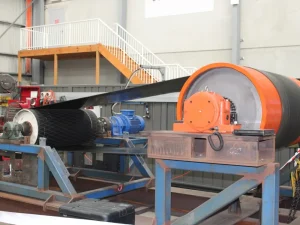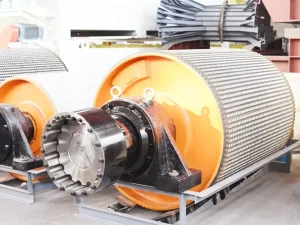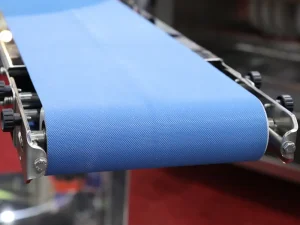Conveyor belts are everywhere, from busy airports to large mining industries. They help move things quickly and efficiently, saving both time and money. However, behind the smooth movement of these belts lies a set of pulleys. One of the key players in this setup is a snub pulley. But what is a snub pulley, and how does it work?
Although this pulley appears small, it plays a crucial role in the conveyor system. So, knowing how it works gives you a clear picture of how conveyor systems stay reliable and efficient. Are you new to the concept of snub pulley? Worry not! This guide will walk you through everything you need to know about the snub pulley, including its parts and function. Let’s get started!
What is a Snub Pulley?

A snub pulley is the type of pulley used in a conveyor system. It does not drive the belt but helps increase the contact between it and the drive pulley. This connection enables the belt to grip the drive pulley more effectively. As a result, the belt remains in the correct position, reducing slippage or loss of control.
In the conveyor system, the drive pulley moves the belt. However, if the belt does not have sufficient contact with the drive pulley, it may slip or lose its grip. That’s where the snub pulley comes in. This pulley is positioned near the drive pulley and wraps the belt around it more tightly. This enhances the belt’s grip and prevents it from slipping.
A snub pulley is usually installed on the return side of the conveyor belt. It is positioned near the drive pulley at an angle to adjust the belt’s direction slightly. This angle also helps improve tension on the belt, keeping it tightly pressed against the drive pulley. Without a snub pulley, the conveyor system would have less control and experience more wear.
Parts of a Snub Pulley
A snub pulley may seem like a simple wheel. However, it works with a series of parts. Each part has a specific role in guiding the belt. Let’s take a closer look at each part and understand its work.
1- Pulley Shell (or Pulley Drum)
The pulley shell is the outer cylindrical surface of the snub pulley. It directly contacts the conveyor belt and handles the pressure and load. Therefore, it must be constructed with strong and durable materials, such as metal. Besides durability, the pulley shell is also made smooth. This smoothness is crucial for generating sufficient friction to guide the belt.
2- Shaft

The shaft is the rod that runs through the middle of the pulley. Its main job is to connect the pulley to the conveyor frame or support the system. As you know, the snub pulley does not power the belt. However, it requires free rotation for proper working. A shaft holds the pulley in position and allows it to rotate freely when needed. Moreover, the shaft should be appropriately aligned to handle the force applied to the pulley during operation.
3- Bearings
Bearings are the parts present on both sides of the pulley where shafts pass through. This mechanical part helps the pulley rotate smoothly with less friction. As a result, the belt does not wear out readily due to reduced friction. This way, bearings improve the pulley’s efficiency and extend the conveyor system’s overall life span. If the bearing fails, the pulley might get stuck or wobble.
4- Hub
The hub connects the pulley shell to the shaft. This connection is crucial to transfer the force between these two parts. As a result, they work as a single unit and remain intact. Further, the hub is made precisely and secured with fasteners. The tightness of these fasteners is crucial. It can cause vibration, imbalance, and misalignments if they get loose.
5- End Discs and Welds
End discs are generally metal plates located at the end of the pulley shells. They connect the shells and hub, giving the pulley a completely circular shape. This connection is usually secured with welding. Therefore, this welding should be strong enough to keep everything firmly in place and secure.
6- Lagging (Optional)
Lagging is a layer of rubber or ceramic material sometimes added to the outside of the pulley shell. It provides extra grip between the pulley and the belt, absorbs shocks, reduces belt slippage, and prevents wear. This lagging is crucial when conveyor belts work in wet and slippery conditions.
Functions of Snub Pulley
Now that you know the parts of the snub pulley, you might wonder: what exactly does it do? You may be surprised to know that this small wheel plays a critical role in the working of the conveyor belt. Let’s discuss some of the key functions that make it stand out!
1- Increases Wrap Angle
One of the snub pulleys’ most essential jobs is to increase the wrap angle. But what does this wrap angle mean? Actually, the wrap angle refers to the portion of the drive pulley that is in contact with the belt. The wrap angle is larger when the belt touches a greater portion of the pulley’s surface. A larger wrap angle increases the grip or fraction between the pulley and belt.
This is where the snub pulley helps. Near the drive pulley, it pulls the belt tighter around it. Now, the belt comes into contact with a large surface of the drive pulley. As a result, the wrap angle increases. This increased contact area enables the drive pulley to grip the belt more tightly. This tightness is especially crucial for fabric conveyor belts, as they become loose more frequently.
2- Improves Belt Traction
Another key function of the snub pulley is improving the belt traction. Traction simply means how well the belt grips the pulley. Good traction between the pulley and belt is crucial in a conveyor system. WHY? It helps the heavy loads move more smoothly and efficiently. So, how does a snub pulley improve this traction?
As I said above, the snub pulley increases the wrap angle. A large wrap angle means the belt comes into contact with the pulley surface more frequently. More contact means more friction, which directly enhances the grip. This extra grip ensures that the belt moves in sync with the pulley, preventing it from slipping. So, a conveyor belt can easily carry heavy loads without risk of misalignment.
3- Reduces Tension on Drive Pulley
The snub pulley also played a key role in reducing the tension of the drive pulley. The drive pulley is connected to a motor. It is responsible for pulling the belt and moving it. Because of such a big duty, it has to handle a lot of tension. Tension is a pulling force that, over time, strains the drive pulley, causing it to wear and potentially damage it.
So, a snub pulley steps into play to reduce that tension. HOW? The snub pulley guides the belt in the right direction and increases the wrap angle. As a result, the entire tension of the drive pulley is distributed evenly across its surface. Now, the drive pulley does not handle all the tension or works hard. A snub pulley takes some of its loads and helps it work more efficiently.
4- Guides the Belt’s Path
The snub pulley also guides the belt in the right direction. Actually, in the long conveyor system, the belt must pass through rollers, pulleys, and frames. Without proper guidance, the belt could wander off-center, become misaligned, or rub against the frame. The result will be severe damage to the belt, causing it to break down. But a snub pulley helped solve this problem.
In such a case, it carefully positions the belt and redirects it to the right path. Moreover, the snub pulley can also adjust the belt’s bend angle. Adjusting this angle guides the belt around corners, into tight spaces, or up and down. Therefore, reducing the side movement of the belt in the incorrect path increases the lifespan of a conveyor belt.
5- Minimizes Belt Wear and Slippage
One of the primary functions of a snub pulley is to minimize belt slippage. Remember, the belt moves continuously in any conveyor system, carrying the loads. This continuous movement over time causes slippage and damage, primarily if the belt is not guided. Moreover, this slippage also happens when the belt loses its grip on the drive pulley.
The belt starts distracting from its path when this occurs or may stop completely. But a snub pulley guides and directs the belt by increasing the wrap angle. A large wrap angle increases traction and reduces the chance of slipping. When the belt remains firmly in place, it can move smoothly and handle heavy loads effectively.
Benefits of Snub Pulley
You must already be familiar with the benefits of conveyor belts. They carry things and help them move from one place to another. However, behind them, snub pulleys play a vital role. You might wonder, what makes them so popular? The answer lies in the advantages of the snub pulley it provides. Let’s dive and explore some common benefits of snub pulley.
1- Longer Life for Conveyor Components
A snub pulley enhances the lifespan of several conveyor belt components. HOW? As I mentioned above, the snub pulley reduces the tension on the drive pulley. This reduction prevents the motor from being heated and helps it work smoothly. Moreover, this pulley type also guides the belt in the right position. As a result, the belt does not rub against other surfaces, which avoids wear. This ensures the longer lifespan of all parts, saves money, and reduces downtime.
2- Improve Energy Efficiency

Another key benefit of a snub pulley is that it helps parts consume less energy. In a conveyor system, energy is needed to move the belt and carry loads. If the belt slips out of its path, the motor has to work harder. As a result, energy consumption increases. However, the snub pulley guides the belt on the right path and moves it efficiently. Also, it reduces the tension from the drive pulley, which operates with motors and consumes energy. The reduced tension automatically reduces the energy burden of driving a motor.
3- Better Belt Alignment and Stability
As I mentioned earlier, the conveyor belt must stay on the correct path. If it shifts to the side or twists, it can cause slippage and severe damage to the belt. That’s where the snub pulley offers one of the benefits. It guides the belt in the correct position by adjusting the angle. This way, it helps the belt move straight and prevents it from drifting off the track. When the belt moves smoothly, the entire conveyor system also moves efficiently.
4- Supports Heavier Loads
In many industries, belts are used to carry heavy loads, such as rocks and large packages. Handling those loads requires extra help. So, a snub pulley helps the belt carry any heavy object. HOW? Actually, this type of conveyor belt pulley increases the wrap angle. Large wrap angles help the belt maintain a grip on the drive pulley. This enhanced grip enables the belt to carry heavy loads without requiring excessive tension.
5- Increased Safety
Safety is a critical factor in any workplace. A snub pulley also enhances the safety of a conveyor belt system. HOW? As you can see, it prevents the belt from misaligning and slipping, thereby improving the overall control system. Moreover, it also guides the belt to remain on the path. If the belt drifts from the track, it can injure nearby workers. So, a snub pulley ensures the belt remains intact on the right path, moves smoothly, and enhances safety.
6- Reduced Maintenance and Repair Costs
Another significant advantage of the snub pulley is that it cuts down the reaper cost. As I said above, it guides the belt to the right place. As a result, the belt does not slip, which can prevent damage and the need for repair. Moreover, it also reduces the tension from the drive pulley, which can cause wear and require replacements. When there is no wear, there is no repair cost. Lastly, with a snub pulley, everything works smoothly, decreasing the overall maintenance cost.
Frequently Asked Questions
What materials are snub pulleys made from?
A snub pulley is usually made from steel or other strong metals. These materials ensure the durability of snub pulleys, providing long lifespans. However, they are sometimes coated with rubber to further enhance their strength, a process known as lagging.
Is there a difference between a snub pulley and an idler pulley?
Yes, there is a big difference. A snub pulley is a specific type of idler pulley. So, all snub pulleys are idler, but not all idler pulleys are snub.
What happens if a snub pulley fails?
If a snub pulley fails, the belt will lose its grip on the drive pulley and slip from its right path. This can damage the belt, leading to downtime for the entire conveyor system.
Conclusion
In the conveyor system, every small part is crucial. One such example includes a snub pulley. This small, wheel-like structure may look simple, but it plays a vital role in the efficient operation of the belt. In this article, I have explained everything about this pulley. For example, it ensures the proper alignment of the belt over the right path.
The snub pulley increases the wrap angle. As a result, the belt improves its grip over the drive pulley. This prevents the belt from slipping and damage. This pulley not only boosts performance but also saves energy. It reduces wear and also cuts down maintenance costs. So, when you see a conveyor belt working efficiently, remember there is a snub pulley behind the scene.
